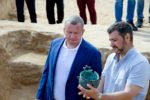 A farmer stumbled on a rare Sarmatian burial while working his land near the village of Nikolskoye in the Astrakhan region of southern Russia this winter. Rustam Mudayev was digging a pit when his bulldozer made an unusual sound. It was the sound of a mechanical digger meeting an ancient bronze pot. He took the vessel to the Astrakhan Museum-Reserve for examination and it was identified as Iron Age artifact.
A farmer stumbled on a rare Sarmatian burial while working his land near the village of Nikolskoye in the Astrakhan region of southern Russia this winter. Rustam Mudayev was digging a pit when his bulldozer made an unusual sound. It was the sound of a mechanical digger meeting an ancient bronze pot. He took the vessel to the Astrakhan Museum-Reserve for examination and it was identified as Iron Age artifact.
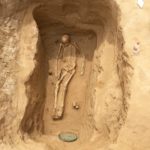 When the snow melted, a team of archaeologists surveyed the find site. The discovered that the bronze pot had emerged from an ancient burial mound. The mound is noted on topographic maps, labeled “Praying Sands,” but had not been archaeologically excavated before. Digging into the mound the team discovered the remains of an adult male buried with weapons, rich adornments and the head of his horse.
When the snow melted, a team of archaeologists surveyed the find site. The discovered that the bronze pot had emerged from an ancient burial mound. The mound is noted on topographic maps, labeled “Praying Sands,” but had not been archaeologically excavated before. Digging into the mound the team discovered the remains of an adult male buried with weapons, rich adornments and the head of his horse.
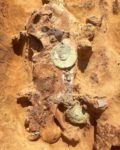 He was tall, just under six feet, and elderly. He had been buried in a closed coffin, his horse’s head in a silver and bronze harness placed on top of it. Inside the coffin archaeologists found a group of gold plaques that are believed to have decorated a pillow on which his head was resting. They also found knives with gold and turquoise decoration, a gold and turquoise belt buckle, a mirror and several pots. A tiny but exquisite gold and turquoise horse head figurine was found between his legs. The objects date to around the 2nd century A.D.
He was tall, just under six feet, and elderly. He had been buried in a closed coffin, his horse’s head in a silver and bronze harness placed on top of it. Inside the coffin archaeologists found a group of gold plaques that are believed to have decorated a pillow on which his head was resting. They also found knives with gold and turquoise decoration, a gold and turquoise belt buckle, a mirror and several pots. A tiny but exquisite gold and turquoise horse head figurine was found between his legs. The objects date to around the 2nd century A.D.
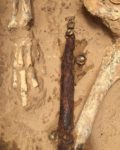 This was an elaborate burial for a nomadic people, an indication of the high status this individual held in his community. The weapons and the horse burial would have been reserved for a warrior and the wealth of the grave goods suggest he was a leader, a chieftain or nobleman.
This was an elaborate burial for a nomadic people, an indication of the high status this individual held in his community. The weapons and the horse burial would have been reserved for a warrior and the wealth of the grave goods suggest he was a leader, a chieftain or nobleman.
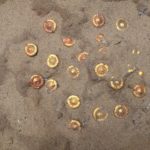 Initially the mound was dated to the Iron Age (4th century B.C. – 4th century A.D.) based on the artifacts, but additional discoveries point to the mound having been used repeatedly starting in the Bronze Age. The team has been digging for less than two weeks and they’ve found two more burials — a woman buried with a bronze mirror and a whole sacrificed lamb and the skeletal remains
Initially the mound was dated to the Iron Age (4th century B.C. – 4th century A.D.) based on the artifacts, but additional discoveries point to the mound having been used repeatedly starting in the Bronze Age. The team has been digging for less than two weeks and they’ve found two more burials — a woman buried with a bronze mirror and a whole sacrificed lamb and the skeletal remains 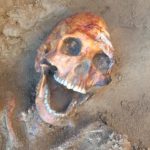 of a young man with an egg-shaped skull. Deliberate cranial deformation was a common practice in the region at the time (actually in pretty much every inhabited region on the globe at various times).
of a young man with an egg-shaped skull. Deliberate cranial deformation was a common practice in the region at the time (actually in pretty much every inhabited region on the globe at various times).
The mound has been looted in the past, but thankfully the looters did a shoddy job of it, only digging up the top Iron Age layer and not even clearing everything out. Archaeologists 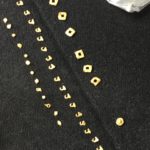 found small pieces of gold fittings or plaques left behind by the tomb raiders. They haven’t gotten to the central burial yet and excavations will continue for another week in the hopes they will reach the original Bronze Age burial that could date back to the third millennium B.C. Once the project is complete, the artifacts will be recovered, conserved and exhibited at the museum.
found small pieces of gold fittings or plaques left behind by the tomb raiders. They haven’t gotten to the central burial yet and excavations will continue for another week in the hopes they will reach the original Bronze Age burial that could date back to the third millennium B.C. Once the project is complete, the artifacts will be recovered, conserved and exhibited at the museum.
Should we also consider the possibility that the horse head was meant as a surprise when he awoke in the afterlife?
The horse head figurine is beautiful, fabulous!
No, that head is just a token :skull:
As everyone knows, there are plenty of horses in the afterlife. Thus, any dead warrior needs to pick the right one.
Also, in contrast to very elaborate burials, where usually 50 followers were killed, their horses also, those dead warriors then deployed around the tumulus (atop their animals) –Here– the rest of the horse was probably eaten.
–i.e. what we refer to as ‘funeral feasting’.
:hattip:
More like a camel in racing-goggles.
And, what a happy skull…Nice set of teeth!
Menander (Μένανδρος Προτήκτωρ) apparently referred to Astrakhan in the 6th century AD, when he rendered the ancient Turcic name for river Volga (i.e. ‘Atıl’/ ‘İtil’) as ‘Attilas (Ἀττίλας)’. Indeed, cranial deformation was common practice in pretty much everywhere at various times. I do wonder though, if the coned headed lad with the pearly smile was an early Hun, or at least one of their (several) relatives and kin.
Back in the Iron Age, Herodotus had written in Bk. I, 203. “The Caspian Sea is apart by itself, not having connection with the other Sea: for all that Sea which the Hellenes navigate, and the Sea beyond the Pillars, which is called Atlantis, and the Erythraian Sea are in fact all one, but the Caspian is separate and lies apart by itself.” […]
He adds, “there are said to be trees which produce leaves of such a kind that by pounding them and mixing water with them they paint figures upon their garments, and the figures do not wash out, but grow old with the woollen stuff as if they had been woven into it at the first: and some say that the sexual intercourse of these people is open like that of cattle.” Ahmad ibn Fadlān, by the way, wrote pretty much the same in the 10th century about the (روس) or ‘Rūsiyyah’ :boogie:
Likewise, Ahmad ibn Fadlan also refers to the ‘Atil’ / Volga: “I have seen the Rus as they came on their merchant journeys and encamped by the Atil.”, they even traded, where a few centuries earlier Menander has had his home base.
The Sarmatians troubled Emperor Aurelius, whose campaign against them is documented on his column in Rome. Quite a find, this grave.
From Bavaria to the Caspian Sea and the Alani and Eastern Sarmatians it is quite a distance.
Soldier and historian Ammianus Marcellinus (b.~ 330) in ‘Res Gestae‘ (Bk.31, ch2. 22):
————-
As for the [Alani] men quiet and placid disposition is sought, danger and war are also a pleasure to them. Among them that man is called happy, who has lost his life in battle, and those who grow old or leave the world from accidental sicknesses, they pursue with bitter reproaches as degenerate and cowardly. Nothing they boast with more pride than having killed a man, and most gloriously they esteem the scalps which they have torn from the heads of those they have slain, which they put as trappings and ornaments on their war-horses.
Utque hominibus quietis et placidis otium est voluptabile, ita illos pericula iuvant et bella. iudicatur ibi beatus qui in proelio profuderit animam, senescentes enim et fortuitis mortibus mundo digressos ut degeneres et ignavos conviciis atrocibus insectantur, nec quicquam est quod elatius iactent quam homine quolibet occiso, proque exuviis gloriosis interfectorum avulsis capitibus detractas pelles pro phaleris iumentis accommodant bellatoriis.